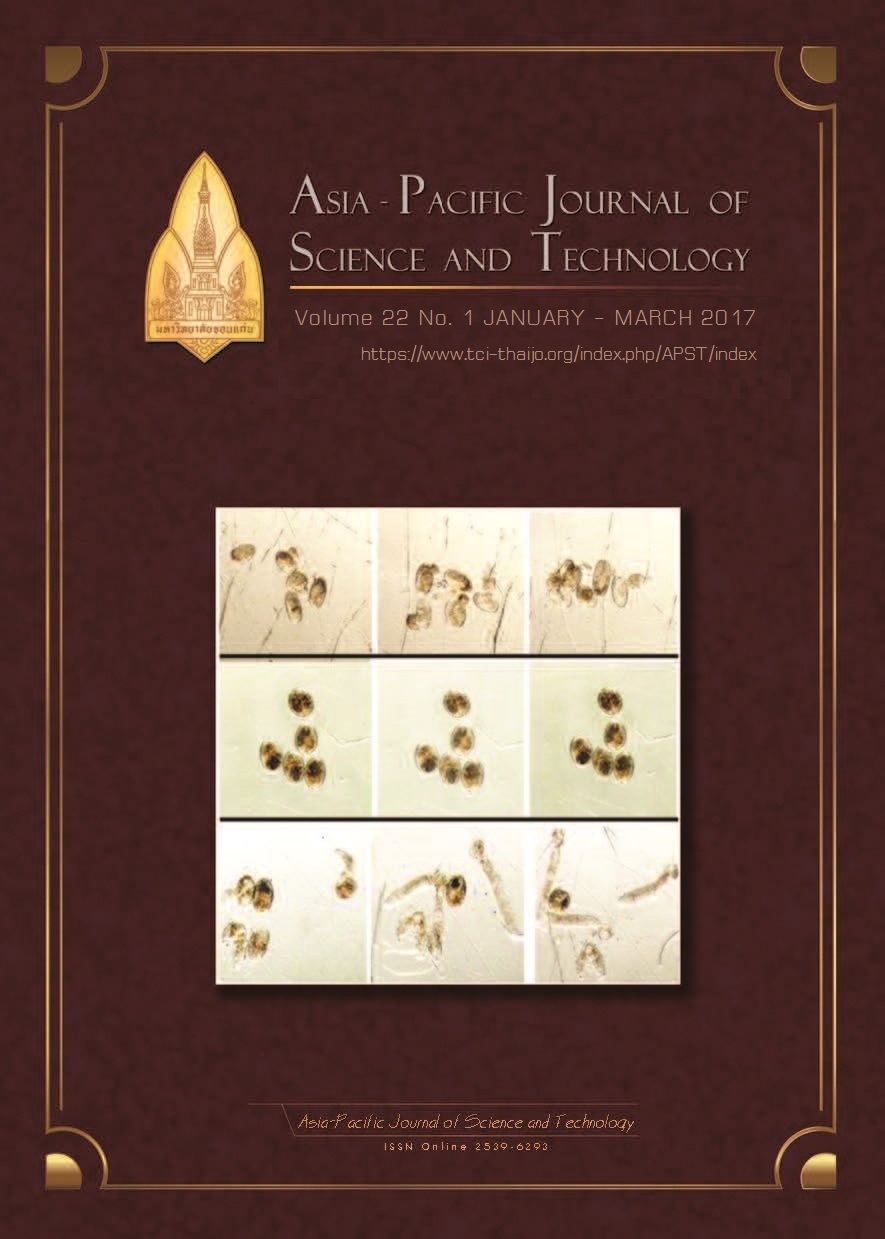Coarse-grained molecular modelling: A powerful approach to simulations of polymers and Biomolecules
Main Article Content
Abstract
Molecular simulation of systems with several-million-atom systems is now tractable due to the rapid increase of computational power in recent years. Nevertheless, there remain cases where all-atom simulations alone are not sufficient. Such cases involve modeling of polymeric and biological materials in which their physical phenomena and properties are usually determined by their structure and dynamics over a wide range of time and length scales. To deal with these issues, simplified models retaining close connections to the underlying atomistic representations, so-called coarse grained (CG) models, have been introduced. This review provides a background and guidelines of CG molecular modeling currently used in polymer and biomolecular research, covering definition, developing techniques, and applications of CG models. An outlook to the future of CG simulations is also presented in this review.
Article Details
References
[2] Ingólfsson, H.I., Lopez, C.A., Uusitalo, J.J., de Jong, D.H., Gopal, S.M., Periole, X., Marrink, S.J., 2014. The power of coarse graining in biomolecular simulations. Wiley Interdisciplinary Reviews. Computational Molecular Science 4, 225–248.
[3] Li, P.C., Makarov, D.E., 2003. Theoretical studies of the mechanical unfolding of the muscle protein titin: Bridging the time-scale gap between simulation and experiment. The Journal of Chemical Physics. 119, 9260-9268.
[4] Shinoda, W., DeVane, R., Klein, M.L., 2008. Coarse-grained molecular modeling of non-ionic surfactant self-assembly. Soft Matter 4, 2454-2462.
[5] Marrink, S.J., Tieleman, D.P., 2013. Perspective on the Martini model. Chemical Society Reviews 42, 6801-6822.
[6] Prasitnok, K., Wilson, M.R., 2013. A coarse-grained model for polyethylene glycol in bulk water and at a water/air interface. Physical Chemistry Chemical Physics 15, 17093-17104.
[7] Lyubartsev, A.P., Laaksonen, A., 1995. Calculation of effective interaction potentials from radial distribution functions: A reverse Monte Carlo approach. Physical Review E 52, 3730-3737.
[8] Reith, D., Putz, M., Muller-Plathe, F., 2003. Deriving effective mesoscale potentials from atomistic simulations. Journal of Computational Chemistry 24, 1624-1636.
[9] Izvekov, S., Voth, G.A., 2005. A multiscale coarse-graining method for biomolecular systems. Journal of Physical Chemistry B 109, 2469-2473.
[10] Marrink, S.J., Risselada, H.J., Yefimov, S., Tieleman, D.P., de Vries, A.H., 2007. The MARTINI force field: Coarse grained model for biomolecular simulations. Journal of Physical Chemistry B 111, 7812-7824.
[11] Brini, E., Algaer, E.A., Ganguly, P., Li, C., Rodriguez-Ropero, F., van der Vegt, N.F.A., 2013. Systematic coarse-graining methods for soft matter simulations - a review. Soft Matter 9, 2108-2119.
[12] Chiu, S.-W., Scott, H.L., Jakobsson, E., 2010. A Coarse-Grained Model Based on Morse Potential for Water and n-Alkanes. Journal of Chemical Theory and Computation 6, 851-863.
[13] Liwo, A., Khalili, M., Scheraga, H.A., 2005. Ab initio simulations of protein-folding pathways by molecular dynamics with the united-residue model of polypeptide chains. Proceedings of the National Academy of Sciences of the United States of America 102, 2362-2367.
[14] Liwo, A., He, Y., Scheraga, H.A., 2011. Coarse-grained force field: general folding theory. Physical Chemistry Chemical Physics 13, 16890-16901.
[15] Ołdziej, S., Czaplewski, C., Liwo, A., Chinchio, M., Nanias, M., Vila, J.A., Khalili, M., Arnautova, Y.A., Jagielska, A., Makowski, M., Schafroth, H.D., Kaźmierkiewicz, R., Ripoll, D.R., Pillardy, J., Saunders, J.A., Kang, Y.K., Gibson, K.D., Scheraga, H.A., 2005. Physics-based protein-structure prediction using a hierarchical protocol based on the UNRES force field: assessment in two blind tests. Proceedings of the National Academy of Sciences of the United States of America 102, 7547–7552.
[16] Rojas, A.V., Liwo, A., Scheraga, H.A., 2007. Molecular dynamics with the united-residue force field: Ab initio folding simulations of multichain proteins. Journal of Physical Chemistry B 111, 293-309.
[17] Klein, M.L., Shinoda, W., 2008. Large-scale molecular dynamics simulations of self-assembling systems. Science 321, 798-800.
[18] Srinivas, G., Mohan, R.V., Kelkar, A.D., 2013. Polymer Micelle Assisted Transport and Delivery of Model Hydrophilic Components inside a Biological Lipid Vesicle: A Coarse-Grain Simulation Study. Journal of Physical Chemistry B 117, 12095-104.
[19] Winter, N.D., Murphy, R.K.J., O'Halloran, T.V., Schatz, G.C., 2011. Development and modeling of arsenic-trioxide--loaded thermosensitive liposomes for anticancer drug delivery. Journal of Liposome Research 21, 106-115.
[20] Ahmad, S., Johnston, B.F., Mackay, S.P., Schatzlein, A.G., Gellert, P., Sengupta, D., Uchegbu, I.F., 2010. In silico modelling of drug-polymer interactions for pharmaceutical formulations. Journal of the Royal Society, Interface 7 Suppl 4, S423-433.
[21] Jorn, R., Savage, J., Voth, G.A., 2012. Proton Conduction in Exchange Membranes across Multiple Length Scales. Accounts of Chemical Research 45, 2002-2010.
[22] Jorn, R., Voth, G.A., 2012. Mesoscale Simulation of Proton Transport in Proton Exchange Membranes. The Journal of Physical Chemistry C 116, 10476-10489.
[23] Johnson, M.E., Head-Gordon, T., Louis, A.A., 2007. Representability problems for coarse-grained water potentials. The Journal of Chemical Physics 126, 144509.
[24] Ghosh, J., Faller, R., 2007. State point dependence of systematically coarse-grained potentials. Molecular Simulation 33, 759-767.
[25] Villa, A., Peter, C., van der Vegt, N.F.A., 2010. Transferability of Nonbonded Interaction Potentials for Coarse-Grained Simulations: Benzene in Water. Journal of Chemical Theory and Computation 6, 2434-44.
[26] Mullinax, J.W., Noid, W.G., 2009. Extended ensemble approach for deriving transferable coarse-grained potentials. The Journal of Chemical Physics 131, 104110.
[27] Chaimovich, A., Shell, M.S., 2011. Coarse-graining errors and numerical optimization using a relative entropy framework. The Journal of Chemical Physics 134, 094112.
[28] Zhang, Z.Y., Lu, L.Y., Noid, W.G., Krishna, V., Pfaendtner, J., Voth, G.A., 2008. A Systematic Methodology for Defining Coarse-Grained Sites in Large Biomolecules. Biophysical Journal 95, 5073-83.
[29] Wilks, T.R., Pitto-Barry, A., Kirby, N., Stulz, E., O'Reilly, R.K., 2014. Construction of DNA-polymer hybrids using intercalation interactions. Chemical Communications 50, 1338-1340.
[30] Cui, H., Webber, M.J., Stupp, S.I., 2010. Self-Assembly of Peptide Amphiphiles: From Molecules to Nanostructures to Biomaterials. Biopolymers 94, 1-18.


